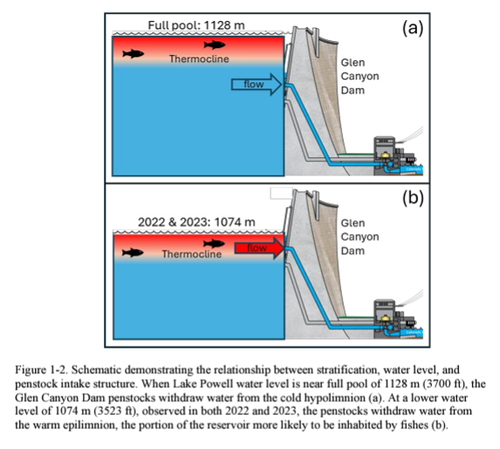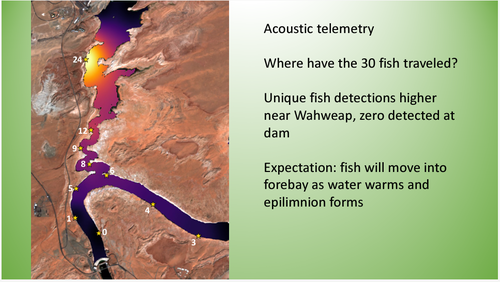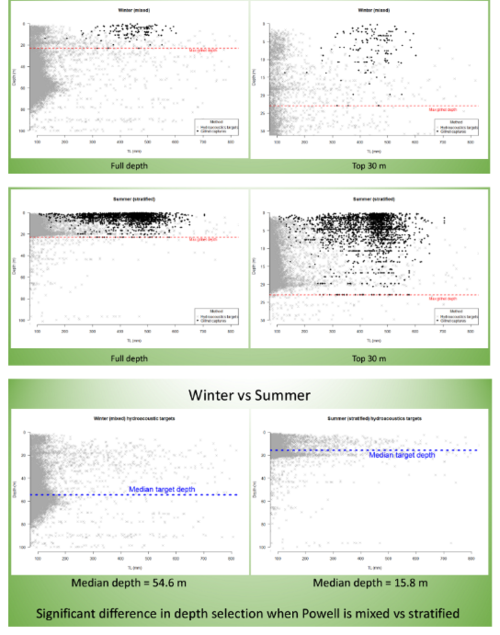- Fact Sheets
- Training
- Knowledge Assessments
- Trivia
- Key Topics
Difference between revisions of "Entrainment"
Cellsworth (Talk | contribs) (Created page with " __NOTOC__ __NOEDITSECTION__ <!-- ------------------------------Banner across top of page------------------------------> {| style="width:100%; background:#fcfcfc; margin-to...") |
Cellsworth (Talk | contribs) |
||
| (2 intermediate revisions by the same user not shown) | |||
| Line 17: | Line 17: | ||
</table> | </table> | ||
| + | [[Image:Entrainment.png|thumb|center|500px| ]] | ||
<!-- | <!-- | ||
| Line 23: | Line 24: | ||
|style="width:60%; font-size:120%;"| | |style="width:60%; font-size:120%;"| | ||
| + | ==Entrainment of warmwater nonnative fish through Glen Canyon Dam== | ||
| + | |||
| + | When the reservoir was cold (<10 °C) and well-mixed, most fishes selected gently sloping habitat such as that found in Wahweap Bay (5 km from GCD), and thus winter entrainment risk is low for most species. When the reservoir was stratified (>20 °C surface temp.) fish were active in the forebay epilimnion within meters of the dam, increasing entrainment when the dam penstock is positioned within the epilimnion, as it was during our study, rather than below the thermocline when the reservoir water level is higher. | ||
| + | |||
| + | |||
| + | Smallmouth Bass Micropterus dolomieu) may survive entrainment at rates above 50% at low water levels, with survival expected to decrease as the water level rises, but remaining problematically high across all water levels where entrainment is expected. Other fishes may survive entrainment at higher rates, depending on physiology. | ||
| + | |||
| + | |||
| + | Minimizing successful nonnative fish passage through GCD is best achieved through maintenance of water levels higher than those in 2022 and 2023, which would decrease both entrainment and survival of entrainment. [https://digitalcommons.usu.edu/cgi/viewcontent.cgi?article=1304&context=etd2023] | ||
|}<!-- | |}<!-- | ||
| Line 40: | Line 50: | ||
|style="color:#000;"| | |style="color:#000;"| | ||
| + | [[Image:Forebay_telemetry.png|thumb|center|500px| ]] | ||
| + | |||
| + | [[Image:Forebay sonor.png|thumb|center|500px| ]] | ||
|} | |} | ||
| Line 53: | Line 66: | ||
|style="color:#000;"| | |style="color:#000;"| | ||
| + | *[https://gcdamp.com/index.php/TCD_Learning_Page Temperature Control Page] | ||
| + | *[http://gcdamp.com/index.php?title=Smallmouth_Bass_Page Smallmouth Bass Page] | ||
| + | *[http://gcdamp.com/index.php?title=Green_Sunfish_Page Green Sunfish Page] | ||
| + | *[http://gcdamp.com/index.php?title=Striped_Bass_Page Striped Bass Page] | ||
|- | |- | ||
| Line 59: | Line 76: | ||
|style="color:#000;"| | |style="color:#000;"| | ||
| + | [https://digitalcommons.usu.edu/cgi/viewcontent.cgi?article=1304&context=etd2023 Friesen, Barrett T., "Invasion Potential of Nonnative Fishes Through a Large Western Dam Into a Prized and Vulnerable Ecosystem" (2024). All Graduate Theses and Dissertations, Fall 2023 to Present. 288. https://digitalcommons.usu.edu/etd2023/288 ] | ||
|- | |- | ||
| Line 65: | Line 83: | ||
|style="color:#000;"| | |style="color:#000;"| | ||
| + | '''2024''' | ||
*[https://www.usbr.gov/uc/progact/amp/twg/2024-01-25-twg-meeting/20240125-TWGMeeting-HydroacousticMonitoring-508-UCRO.pdf Hydroacoustic Monitoring ] | *[https://www.usbr.gov/uc/progact/amp/twg/2024-01-25-twg-meeting/20240125-TWGMeeting-HydroacousticMonitoring-508-UCRO.pdf Hydroacoustic Monitoring ] | ||
| + | |||
| + | '''2023''' | ||
*[https://www.usbr.gov/uc/progact/amp/twg/2023-11-08-twg-meeting/20231108-NonnativeFishDistributionLakePowellForebay-508-UCRO.pdf Characterizing the fish assemblage in the Lake Powell forebay and identifying the potential for nonnative fish escapement into the Lower Colorado River ] | *[https://www.usbr.gov/uc/progact/amp/twg/2023-11-08-twg-meeting/20231108-NonnativeFishDistributionLakePowellForebay-508-UCRO.pdf Characterizing the fish assemblage in the Lake Powell forebay and identifying the potential for nonnative fish escapement into the Lower Colorado River ] | ||
*[https://www.usbr.gov/uc/progact/amp/twg/2023-04-13-twg-meeting/20230413-HydroacousticFishDistributionLakePowell-508-UCRO.pdf Hydroacoustic Fish Distribution] | *[https://www.usbr.gov/uc/progact/amp/twg/2023-04-13-twg-meeting/20230413-HydroacousticFishDistributionLakePowell-508-UCRO.pdf Hydroacoustic Fish Distribution] | ||
*[https://www.usbr.gov/uc/progact/amp/twg/2023-04-13-twg-meeting/20230413-CharacterizingFishAssemblageLakePowellForebay-508-UCRO.pdf Characterizing the fish assemblage in the Lake Powell forebay and identifying the potential for nonnative fish escapement into the Lower Colorado River] | *[https://www.usbr.gov/uc/progact/amp/twg/2023-04-13-twg-meeting/20230413-CharacterizingFishAssemblageLakePowellForebay-508-UCRO.pdf Characterizing the fish assemblage in the Lake Powell forebay and identifying the potential for nonnative fish escapement into the Lower Colorado River] | ||
*[https://www.usbr.gov/uc/progact/amp/amwg/2023-02-16-amwg-meeting/20230216-GlenCanyonDamFishExclusionProjectOverview-508-UCRO.pdf Glen Canyon Dam Fish Exclusion: Project Overview] | *[https://www.usbr.gov/uc/progact/amp/amwg/2023-02-16-amwg-meeting/20230216-GlenCanyonDamFishExclusionProjectOverview-508-UCRO.pdf Glen Canyon Dam Fish Exclusion: Project Overview] | ||
| + | |||
| + | '''2022''' | ||
*[https://www.usbr.gov/uc/progact/amp/twg/2022-10-13-twg-meeting/20221013-HydroacousticFishDistribution-508-UCRO.pdf Hydroacoustic Fish Distribution ] | *[https://www.usbr.gov/uc/progact/amp/twg/2022-10-13-twg-meeting/20221013-HydroacousticFishDistribution-508-UCRO.pdf Hydroacoustic Fish Distribution ] | ||
*[https://www.usbr.gov/uc/progact/amp/amwg/2022-08-18-amwg-meeting/20220818-GlenCanyonDamFishEscapementOptions-508-UCRO.pdf Glen Canyon Dam Fish Escapement Options ] | *[https://www.usbr.gov/uc/progact/amp/amwg/2022-08-18-amwg-meeting/20220818-GlenCanyonDamFishEscapementOptions-508-UCRO.pdf Glen Canyon Dam Fish Escapement Options ] | ||
| Line 77: | Line 100: | ||
*[https://www.usbr.gov/uc/progact/amp/twg/2022-04-13-twg-meeting/20220413-CharacterizinFishAssemblageLakePowellForebay-Presentation-508-UCRO.pdf Characterizing the fish assemblage of the Lake Powell forebay: identifying the potential for nonnative fish escapement through Glen Canyon Dam and into the lower Colorado River ] | *[https://www.usbr.gov/uc/progact/amp/twg/2022-04-13-twg-meeting/20220413-CharacterizinFishAssemblageLakePowellForebay-Presentation-508-UCRO.pdf Characterizing the fish assemblage of the Lake Powell forebay: identifying the potential for nonnative fish escapement through Glen Canyon Dam and into the lower Colorado River ] | ||
*[https://www.usbr.gov/uc/progact/amp/twg/2022-04-13-twg-meeting/20220413-TWGMeeting-FinalMinutes-508-UCRO.pdf Glen Canyon Fish Escapement Options ] | *[https://www.usbr.gov/uc/progact/amp/twg/2022-04-13-twg-meeting/20220413-TWGMeeting-FinalMinutes-508-UCRO.pdf Glen Canyon Fish Escapement Options ] | ||
| + | |||
| + | '''2021''' | ||
*[https://www.usbr.gov/uc/progact/amp/twg/2021-10-14-twg-meeting/20211014-ExistingPlannedMonitoringNon-NativeAquaticSpeciesLakePowellBelowGlenCanyonDam-Presentation-508-UCRO.pdf Existing and Planned Monitoring of Non-Native Aquatic Species in Lake Powell and Below Glen Canyon Dam] | *[https://www.usbr.gov/uc/progact/amp/twg/2021-10-14-twg-meeting/20211014-ExistingPlannedMonitoringNon-NativeAquaticSpeciesLakePowellBelowGlenCanyonDam-Presentation-508-UCRO.pdf Existing and Planned Monitoring of Non-Native Aquatic Species in Lake Powell and Below Glen Canyon Dam] | ||
*[https://www.usbr.gov/uc/progact/amp/twg/2021-10-14-twg-meeting/20211014-LakePowellFishMonitoringStudy2021-2024-Presentation-508-UCRO.pdf Lake Powell Fish Monitoring Study 2021 -2024 ] | *[https://www.usbr.gov/uc/progact/amp/twg/2021-10-14-twg-meeting/20211014-LakePowellFishMonitoringStudy2021-2024-Presentation-508-UCRO.pdf Lake Powell Fish Monitoring Study 2021 -2024 ] | ||
Latest revision as of 14:36, 1 October 2024
|
|
Entrainment of warmwater nonnative fish through Glen Canyon DamWhen the reservoir was cold (<10 °C) and well-mixed, most fishes selected gently sloping habitat such as that found in Wahweap Bay (5 km from GCD), and thus winter entrainment risk is low for most species. When the reservoir was stratified (>20 °C surface temp.) fish were active in the forebay epilimnion within meters of the dam, increasing entrainment when the dam penstock is positioned within the epilimnion, as it was during our study, rather than below the thermocline when the reservoir water level is higher.
|
| -- |
-- |
-- |
|---|


